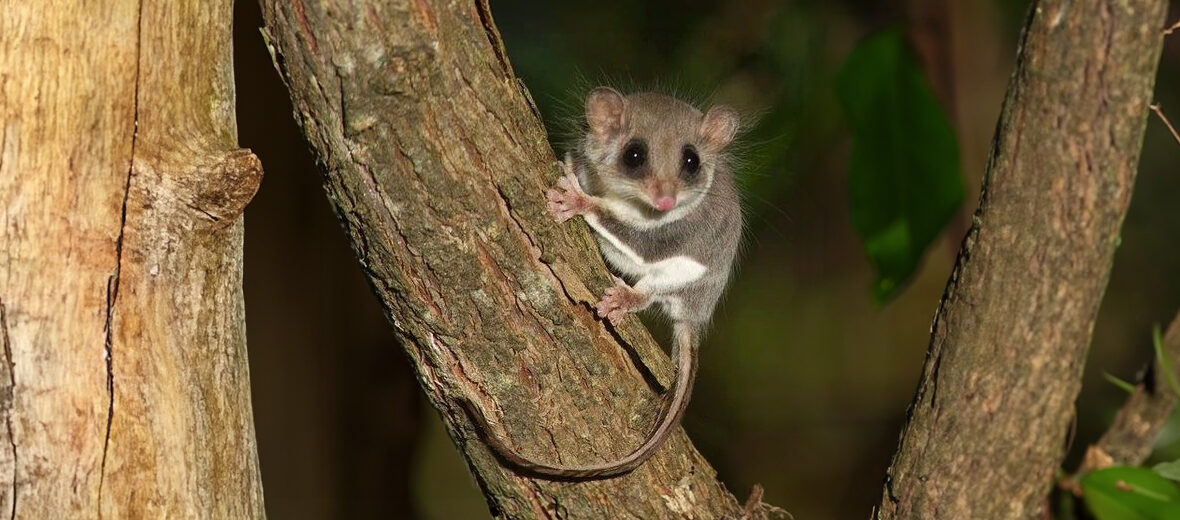
The feathertail glider, aka pygmy gliding possum, pygmy glider, pygmy phalanger, flying mouse, or flying phalanger, is the world’s smallest gliding mammal and subsequently the smallest gliding marsupial. They hail from eastern Australia. These diminutive marsupials face the threat of habitat loss and destruction at the hands of the logging industry, however, they are abundant enough to be listed as Least Concern by the IUCN. Their population trend is stable.
First the Stats…
Scientific name: Acrobates pygmaeus
Weight: Up to .42 ounce
Length: Up to 3.1 inches, plus up to a 3.15 inch tail
Lifespan: Up to 5+ years
Now on to the Facts!
1.) These gliders have a rather large number of whiskers that sprout from their snout, cheeks, and from the base of each ear.
2.) Just like other gliding mammals, these gliders have a patagium (membrane used to aid in gliding) that stretches between the forelegs and hind legs.
3.) Their tail is only slightly prehensile (used as an additional appendage).
4.) The tongue of these gliders is long and thin. It reaches as long as 0.43 inches, and has several long papillae that lend to a brush-like appearance.
5.) The structure of the ear is also quite strange, since the animal has a bony disc with a narrow crescent-shaped slit just in front of the eardrum. The purpose of this bone is not known, however it may act as a Helmholtz resonator (aka wind throb, which refers to air resonance in a cavity) enhancing sensitivity to certain frequencies of sounds.
But wait, there’s more on the feathertail glider!
6.) Their marsupium (pouch) opens towards the front, as is commonplace in diprotodont (having 2 front teeth) marsupials, and contains 4 teats.
7.) These gliders are a monotypic species (not possessing any subspecies).
Did you know…?
The brain of these gliders has been measured as weighing just .013 ounce!
8.) Fossils have been identified from deposits in Queensland dating back to 0.5 million years ago, during the late Pleistocene epoch.
9.) They can tolerate a wide range of forest habitats but prefer tall, wet, or dry forests with eucalyptus trees.
10.) These critters are omnivorous (eat meat and plant matter), feeding on nectar, pollen, and various arthropods like ants, moths, and termites.
But wait, there’s still more on the feathertail glider!
11.) They are arboreal (spend most of their time in trees), and although they do sometimes descend to the ground to forage, they spend up to 87% of their time over 50 feet above the ground in the tall eucalyptus trees.
12.) Feathertail gliders are nocturnal (active at night), like other glider species.
Did you know…?
In several experiments, they have proved to be able to climb vertical panes of glass. This is due to a combination of fine skin ridges and sweat that allows their feet to serve as suction cups.
13.) They are gregarious animals, and up to 5 individuals can share a single nest, especially during the breeding season.
14.) They are highly adept climbers, that are capable of clinging to the smooth trunks of eucalyptus trees.
15.) These gliders have the ability to glide up to 92 feet, and do so up to 3 times an hour, each night.
But wait, there’s still a little more on the feathertail glider!
16.) Feathertail gliders don’t hibernate, but they can enter into torpor (a state of sleep) if the weather gets cold enough.
17.) Gliders in torpor curl into a tight ball, wrap their tail around themselves and fold their ears flat, and often huddle together with up to 4 other gliders to reduce heat loss and conserve energy.
Did you know…?
During torpor their body temperature can dip as low as 36ºF, and oxygen absorption is just 1% of what it it is during their waking period!
18.) Breeding season lasts from July – January.
19.) Females undergo up to a 100 day gestation (pregnancy) that yields up to 4 joeys, up to 2 times a season.
20.) At up to 65 days, the joeys leave mom’s marsupium (pouch) and are fully weaned in up to 4 months.
But wait, there’s still a tad more on the feathertail glider!
21.) While the first batch of joeys is developing in the marsupium, the second batch are kept in embryonic diapause (delayed implantation – the embryos do not implant in the uterus), until the first batch leaves the safety of mom’s pouch.
22.) Multiple paternity is common, even within litters, as the females are sexually promiscuous (have multiple reproductive partners).
Did you know…?
The New Zoo in Poznań, Poland, was the first European zoo to begin showing these gliders in 1999 (their animals originated from Taronga Zoo). Some of them born in Poznań were sent to other European zoos, meaning that the entire European captive population is of Poznań descent.
23.) Taronga Zoo (Sydney, Australia) was the first zoo to successfully breed feathertail gliders in captivity.
24.) A feathertail glider was displayed on the backside of the Australian 1-cent coin until 1991 when the 1-cent coin was discontinued.
25.) They are preyed on by snakes, owls, foxes, dogs, and cats.
Now a Short Feathertail Glider Video!
Be sure to share & comment below! Also, check out the Critter Science YouTube channel. Videos added regularly!
Want to suggest a critter for me to write about? Let me know here.
Some source material acquired from: Wikipedia & IUCN
Photo credit: Fandom




